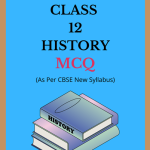NCERT Class 12 History MCQ Chapter 11 Rebels and The Raj Solutions to each chapter is provided in the list so that you can easily browse through different chapters NCERT Class 12 History MCQ Chapter 11 Rebels and The Raj and select need one. NCERT Class 12 History MCQ Chapter 11 Rebels and The Raj Question Answers Download PDF. NCERT History MCQ Class 12 Solutions.
NCERT Class 12 History MCQ Chapter 11 Rebels and The Raj
Also, you can read the NCERT book online in these sections Solutions by Expert Teachers as per Central Board of Secondary Education (CBSE) Book guidelines. CBSE Class 12 History MCQ Solutions are part of All Subject Solutions. Here we have given NCERT Class 12 History MCQ Part – I: Themes in Indian History, History MCQ Part – II: Themes in Indian History, History MCQ Part – III: Themes in Indian History. NCERT Class 12 History MCQ Chapter 11 Rebels and The Raj Notes, NCERT Class 12 History MCQ Notes for All Chapters, You can practice these here.
Rebels and The Raj
Chapter: 11
| THEMES IN INDIAN HISTORY (PART – III) |
| MCQ |
1. Mutiny broke out in the Cantonment of Meerut on:
(a) 10 May, 1857.
(b) 9 May 1859.
(c) 5 May 185.
(d) 10 May 1757.
Ans: (a) 10 May, 1857
2. What is a Bell of arms?
(a) It is a storeroom in which weapons are kept.
(b) It is darkroom where government secret reports are kept.
(c) It is big hall where special prayers are held with drums and bells.
(d) None of the above.
Ans: (a) It is a storeroom in which weapons are kept.
3. Firangi is a term of:
(a) Hindi origin.
(b) Persian origin
(c) Arabic origin.
(d) French origin.
Ans: (b) Persian origin.
4. Who was Kunwar Singh?
(a) He was a local zamindar in Arrah in Bihar.
(b) He was a rich zamindar in Aligarh in Uttar Pradesh.
(c) He was a Talukedar in Awadh.
(d) None of the above.
Ans: (a) He was a local zamindar in Arrah in Bihar.
5. Gonoo became a rebel leader of the:
(a) Santhal tribals of a region.
(b) Kol tribals of a region.
(c) Bhil tribals of a region.
(d) None of the above.
Ans: (b) Kol tribals of a region.
6. Shah Mal lived in a large village in pargana named:
(a) Barout in Uttar Pradesh.
(b) Bareilly in Uttar Pradesh.
(c) Banaras in Uttar Pradesh.
(d) Burhanpur in Southern India.
Ans: (a) Barout in Uttar Pradesh.
7. The Enfield riffles were introduced initially by Governor General named:
(a) Hardinge.
(b) Dalhousie.
(c) Wellesely.
(d) William Bentinck.
Ans: (a) Hardinge.
8. The British established laws to abolish customs like sati in:
(a) 1929.
(b) 1829.
(c) 1629.
(b) 1829.
Ans: (b) 1829.
9. Who has uttered the statement, “A cherry that will drop into our mouth one day”?
(a) Lord Dalhousie.
(b) Lord William Bentinck.
(c) Lord Hardingle.
(d) Lord Wellesley.
Ans: (a) Lord Dalhousie.
10. Which territory was the “nursery of the Bengal Army”.
(a) Jhansi.
(b) Lucknow.
(c) Awadh.
(d) Gwalior.
Ans: (c) Awadh.
11. Who had written popular lines “Khooblari mardani woh to Jhansi Wali Rani Thi”:
(a) Prathavi Raj Chauhan.
(b) Mahadevi.
(c) Subhadra Kumari Chauhan.
(d) Methalisharan.
Ans: (c) Subhadra Kumari Chauhan.
12. Match the following:
| List I | List II |
| (i) Delhi. | (a) Birjis Qadir. |
| (ii) Kanpur. | (b) Kunwar Singh. |
| (iii) Arrah. | (c) Bahadur Shah. |
| (iv) Lucknow. | (d) Nana Sahib. |
Options: (i) (ii) (iii) (iv)
A. (α) (c) (b) (d)
B. (c) (d) (b) (α)
C. (a) (b) (c) (d)
D. (a) (b) (d) (c)
Ans: B. (c) (d) (b) (α)
13. What were the socio- religious causes during this period that caused unrest among people?
(i) Activities of Christian missionaries.
(ii) Attempts to bring social reforms.
(iii) Taxation of mosques and temple lands.
(iv) Racial superiority complex of Britishers.
Options:
(a) (i), (ii) and (iii)
(b) (iii) and (iv)
(c) Only (iii)
(d) All of the above.
Ans: (d) All of the above.
14. Find the incorrect match for the centre of the revolt and associated British officer:
(a) Delhi: James Neill.
(b) Kanpur: Sir Hugh wheeler.
(c) Lucknow: Henry Lawrence, Sir Collin Campbell.
(d) Jhansi: Sir Hugh Rose.
Ans: (a) Delhi: James Neill.
15. Sir Huge Rose described whom as the best and bravest military leader of the rebel’?
(a) Begum Hazrat Mahal.
(b) Rani Laxmi Bai.
(c) Kunwar Singh.
(d) Bahadur Shah Zafar.
Ans: (b) Rani Laxmi Bai.

Hi! my Name is Parimal Roy. I have completed my Bachelor’s degree in Philosophy (B.A.) from Silapathar General College. Currently, I am working as an HR Manager at Dev Library. It is a website that provides study materials for students from Class 3 to 12, including SCERT and NCERT notes. It also offers resources for BA, B.Com, B.Sc, and Computer Science, along with postgraduate notes. Besides study materials, the website has novels, eBooks, health and finance articles, biographies, quotes, and more.




